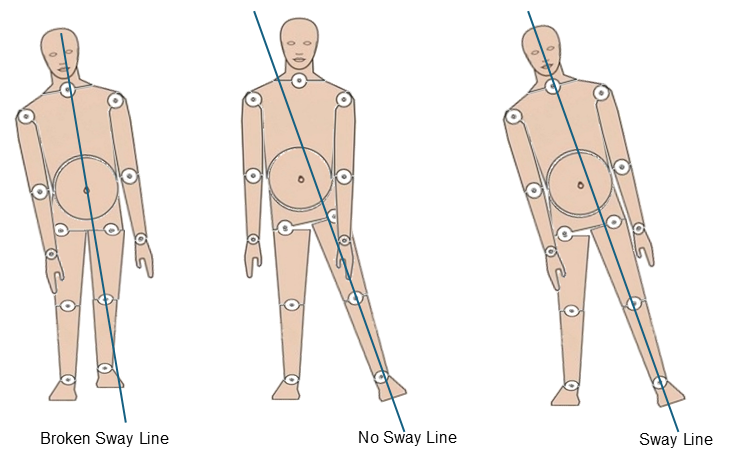Sway
The Purpose of Sway
Have you ever watched runners turning the corner on a track? Notice how they lean toward the center of the curve? The same thing happens on a bicycle — we instinctively lean into the curve.
Why?
Because if we didn’t, we’d get pulled outward — toppled by the inertia of our own momentum.
In dance, a similar thing occurs — but with more style and a lot more rhinestones.
In this section, we’ll go on a journey with an imaginary couple named Leader and Follower to explore how and why sway happens — not because we choose to lean, but because the laws of motion make it inevitable.
The historical (legacy) terms "Technical Sway" and "Upper Body Sway (Body Sway)" use the Pendulum and Metronome analogies, this section describes what Sway is and how to achieve it.
There are different types of Sway:
There are also legacy descriptions for sway that use metaphors rather than concrete physics:
⚠️ Spoiler:
Sway isn’t a pose. It’s the body’s way of balancing rotation and containing the momentum of the free leg during turns.
Sway is inextricably linked with Rise and Fall to the point that Sway is almost impossible without it. If you are being taught Sway without Rise and Fall you really must read this
Sway is used to maintain the Center of Gravity (COG) over the Center of Support (COS) during actions such as:
- Lateral (sideways) travel
- Directional changes
- Any step where a turn (rotation of the Frame (and Hip) is initiated
Our intrepid Leader and Follower try a Natural Turn
Let’s follow our intrepid Leader in attempts a Natural Turn in Waltz:
- Step 1: RF forward
- Footwork: Heel-toe
- Rise: Commence to rise at the end of 1
That means he’s rolling onto the ball of the right foot, with the heel off the ground and the left leg swinging through.
Now here comes the trouble...
As the body rotates to the right and the free leg swings past, the Leader feels a sudden “whoa!”
Like he’s being pulled left, while rotating right.
It’s disorienting — he almost topples.
After a few wobbly attempts, confused mutterings about gravity, and betrayal by his own foot, the realization hits:
He isn’t falling because he’s rotating.
He’s falling because he’s being pulled over
Here's a no foot rise sway example.
💡 Sway To The Rescue
Just the upper body inclines slightly to the right — toward the inside of the turn.
And just like that… balance returns.
Sway here is:
- Not decorative
- Not optional
- And not arbitrary
It’s a counterbalancing shape that allows the dancer to:
- Maintain vertical alignment over the standing foot
- Counter the angular momentum of the free leg
- Preserve stability during turning with rise
This isn’t about throwing the head or flailing the torso. It’s subtle, mechanical, and completely natural once you feel it.
Don't Force Sway:
Here are some Sway examples:

- Broken Sway Where the dancer is just leaning to the right for no reason at all. It does nothing and looks horrible.
- No Sway Where the dancer has swung their left leg to the side as part of a rotation and.... there is no sway. In that position the dancer has almost certainly toppled to their left foot.
-
Sway Line! An example of correct sway as can be seen from the line from the neck to the ankle and foot and has come as a natural consequence of the rotation without any 'help' from the dancer.
This is also the most stable form as the clockwise and counter clockwise torques are balanced. And it looks really good too.
🔗 Related Topics
-
Sway with No Foot Rise
What happens when dancers try to lean without rising first. Spoiler: it goes badly. -
Sway with Foot Rise
How proper foot rise and sway combine to create effortless rotation and balance. -
Biomechanics of Inertial Sway
The full Newtonian breakdown — forces, torques, and a simulation to prove sway’s necessity.
Without sway, the dancer fights physics.
With sway, they dance with it.